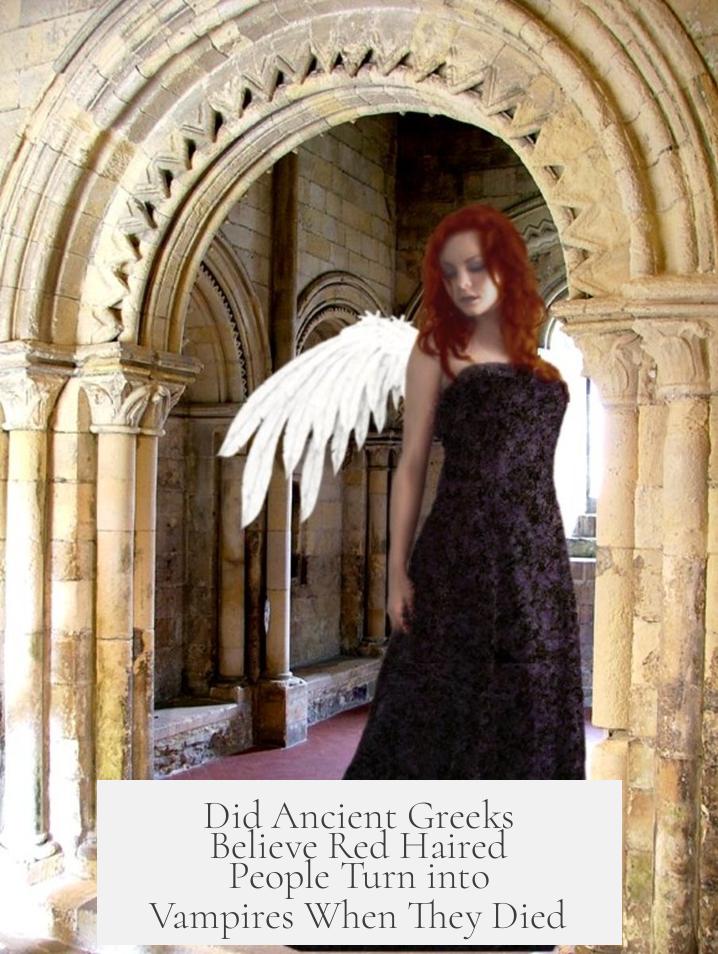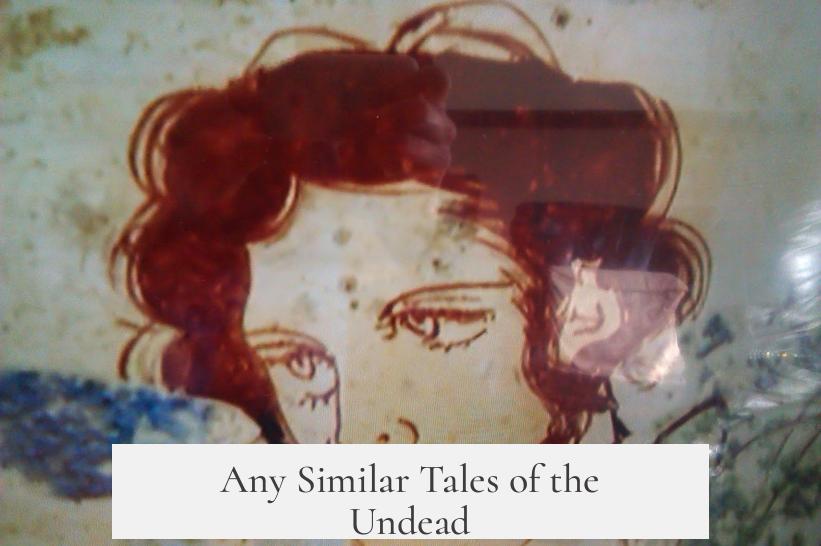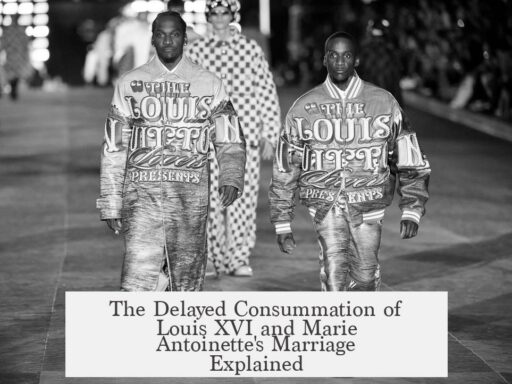Ancient Greeks did not believe that red-haired people turned into vampires after death. There is no evidence in ancient Greek literature or mythology linking red hair to vampirism or any form of undead transformation. The concept of vampires as understood today is absent from ancient Greek culture. The word “vampire” itself does not exist in ancient Greek language or texts.
Ancient Greek mythology and folklore include various night monsters and spirits. These entities represent dangers to the living but have no connection to hair color, including red hair.
- Ἔμπουσα (Empousa): A demonic spirit with features from different animals, often capable of shape-shifting. She sometimes seduces men to harm or consume them. Hekate, a goddess linked to magic and the underworld, was believed to send these spirits. Empousa’s traits resemble a succubus in later stories such as Philostratos’ Life of Apollonios.
- Λάμια (Lamia): A monstrous female spirit who attacked and devoured children.
- Μορμώ (Mormo): Another female spirit that could take animal forms and prey on children.
- Γελλώ (Gello): The ghost of a woman who died unmarried, known to attack women, pregnant women, and foetuses.
- Στρίξ (Strix): A supernatural bird that invaded houses and strangled children.
These creatures appear extensively in ancient Greek literature, notably discussed in Sarah Iles Johnston’s 1999 work Restless Dead: Encounters Between the Living and the Dead in Ancient Greece. None of these spirits are described with any reference to hair color. The focus of their malevolence centers mostly on children and vulnerable women rather than physical traits like hair.
In fact, the monster imagery in ancient Greek folklore is primarily female-dominated. This trend ties directly to female spirits and goddesses like the Erinyes (Furies) and Hekate. Male monsters are less common and rarely connected with vampiric or undead traditions. The werewolf is one rare male example.
Some terms related to these monsters also appear in metaphorical uses in classical Greek texts. For example, the term ἔμπουσα was used as an insult by Demosthenes and Aristophanes toward women perceived as obstructive or harmful. These usages do not imply supernatural belief but function as rhetorical insults.
Additionally, ancient Greek accounts include instances of revenant phenomena—spirits or bodies returning after death to haunt or seduce the living. For example, Phlegon’s Wonders (2nd century CE) describes a woman returning after death to seduce a guest in her parents’ home. Still, these stories do not involve any association with red hair nor do they picture these revenants as vampires.
Overall, vampires as undead, blood-sucking beings appear later in folklore, mainly in Eastern European traditions. The notion of hair color, especially red hair, marking someone as likely to become a vampire is not found in ancient Greek mythology or folklore.
| Aspect | Ancient Greek Belief |
|---|---|
| Vampires | No concept or term existed in ancient Greece. |
| Red Hair | No association with monsters or spirits. |
| Night Monsters | Mostly female spirits like Empousa, Lamia, Mormo. |
| Monsters’ Traits | Linked to harming children, women; no hair color references. |
| Revenants | Exist in some stories but not connected to hair color or vampirism. |
- The ancient Greek language lacks a word for vampire or undead beings based on hair color.
- Monsters predominantly appear as female spirits harmful to children or women, unrelated to hair traits.
- Red hair is not linked to supernatural danger or transformation after death in Greek myths.
- Vampire folklore, as recognized today, developed after the ancient Greek period, mainly in Eastern Europe.
- Some revenant tales exist in Greek texts but contain no mention of red hair or vampiric traits.
Did Ancient Greeks Believe Red Haired People Turn into Vampires When They Died?

Short answer: No, ancient Greeks did not believe red-haired people turned into vampires after death. That’s the verdict after sifting through what we know about Greek myths, legends, and folklore. If you were hoping for an epic tale linking fiery hair to bloodsucking creatures, ancient Greece doesn’t offer that plotline. Let’s break down why.
First off, there’s no word in ancient Greek for “vampire.” Unlike Slavic folklore or later European legends, the idea of a revenant lurking to suck blood just doesn’t exist there. Ancient Greeks had plenty of night monsters, sure, but none resemble the vampires we know today—and none are connected to red hair.
Night Monsters Without Red Hair Drama
Ancient Greek stories are filled with creepy spirits and monsters, but these creatures focus on harm to the vulnerable—kids, women, or picky philosophers—rather than hair color.
- ἔμπουσα (émpousa): Think of a shapeshifting spirit, part human, part animal, sometimes sent by the goddess Hekate. In one story, it seduces a young male philosopher, then devours him. No mention of red hair here—just deadly seduction.
- λάμια (lámia): This female monster targets children, attacking them in shadows. Scary? Absolutely. Hair color? Not in sight.
- μορμώ (mormó): A spirit taking various animal forms, also preying on kids.
- γελλώ (gelló): The ghost of a woman who died unmarried, known for attacking other women and children. Again, hair? Irrelevant.
- στρίξ (strix): A birdish spirit flying into houses to strangle children. Hair color isn’t listed as a trait anywhere.
Sarah Iles Johnston’s 1999 book, Restless Dead: Encounters Between the Living and the Dead in Ancient Greece, paints an extensive picture of these monsters. But here’s the kicker—none mention hair color, let alone red hair as a defining or ominous trait. The terrifying elements come from behavior and form—not from your locks.
Monsters as Insults and Female Figures
Interestingly, these monsters also serve as punchlines to ancient insults or metaphors. For example, the demonic ἔμπουσα was hurled as an insult against someone’s mother by the orator Demosthenes. Aristophanes uses a similar metaphor in his plays. So, these beasts had cultural staying power but not as literal monsters turning redheads into vampires.
And note—the monsters are mostly female. This reflects the influence of gods like Hekate and mythic entities such as the Erinyes (the Furies). Male monsters? Rare. There are occasional werewolves, but that’s a separate story.
What About Red Hair?
Red hair in ancient Greek culture didn’t carry vampire stigma. Sure, Greeks noticed and often mentioned red or auburn hair in poetry and art. Sometimes it symbolized fiery temperament or foreign origins. But they didn’t link it to the undead or supernatural dangers.
So no, red hair didn’t doom you to rise from the grave as a monster hungry for blood. Sounds like a relief, right?
Any Similar Tales of the Undead?

There are ghost stories involving revenants or spirits returning after death. For instance, Phlegon’s Wonders from the 2nd century CE recounts a woman who returns, seduces a guest at her parents’ house, then causes trouble. Charming, maybe, but not vampiric—and there’s no mention of hair color.
These “revenant” tales hint at a fascination with the dead returning, but the traits and stories differ greatly from vampirism as we know it today.
Why the Confusion? Vampire Lore Develops Elsewhere
The vampire myth as we recognize it today mostly comes from Slavic folklore, Eastern Europe, and later European imagination, evolving far later than the ancient Greek era. The Greeks had ghosts, shades, and monstrous creatures, but the idea of undead bloodsuckers doesn’t arise until much later.
Could the fiery nature of red hair have sparked vampire myths elsewhere? Possibly. In medieval and modern European folklore, unusual hair colors or traits sometimes linked to superstition. But in ancient Greece, redheads were simply known as being… redheaded.
Practical Takeaways for Myth Buffs and Hair Enthusiasts
- If you’re a redhead hunting ancient vampire lore, toss your garlic elsewhere. Greek myths don’t qualify.
- If someone slanders you by calling your mom an ἔμπουσα, maybe take it as a fun (if old-fashioned) diss—no need to fear monster ancestors.
- When exploring vampire mythology, start with Slavic and Eastern European legends—not ancient Greeks.
- Red hair still fascinates, but it’s more about personality and beauty in Greek poetry than curses or curses of turning undead.
In Conclusion
The idea that ancient Greeks believed red haired people turn into vampires after death is a myth with no basis in ancient texts or cultural beliefs. They had plenty of night monsters, but none match the vampire stereotype, nor do any link to hair color. Red-haired individuals roamed ancient Greece safely, unshadowed by vampire myths.
When did vampire myths really begin? Much later, and far away from the Mediterranean. Ancient Greece’s legacy for us is rich and vivid—but the “red-haired vampire” trope isn’t one of them.
So, if you’re rocking ginger locks today, celebrate the fiery strands and the ancient stories of warriors, poets, and gods who noticed your shade with admiration, not fear.




